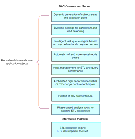| Bookshelf Home | Contents | Index | PDF |   |
|
Oracle® Business Intelligence Data Warehouse Administration Console Guide > Overview of Oracle Business Analytics Warehouse > About the Data Warehouse Administration ConsoleThe DAC provides a framework for the entire life cycle of data warehouse implementations. It allows you to create, configure, execute, and monitor modular data warehouse applications in a parallel, high-performing environment. For information about the DAC process life cycle, see About the DAC Process Life Cycle. The DAC complements the Informatica ETL platform. It provides application-specific capabilities that are not prebuilt into ETL platforms. For example, ETL platforms are not aware of the semantics of the subject areas being populated in the data warehouse nor the method in which they are populated. The DAC provides these application capabilities at a layer of abstraction above the ETL execution platform, as illustrated in Figure 3. Important DAC FeaturesImportant DAC features allow you to do the following: Minimize install, setup, and configuration time
Manage metadata driven dependencies and relationships
Provide reporting and monitoring to isolate bottlenecks Utilize performance execution techniques
|
  |
| Oracle® Business Intelligence Data Warehouse Administration Console Guide | Copyright © 2007, Oracle. All rights reserved. | |

